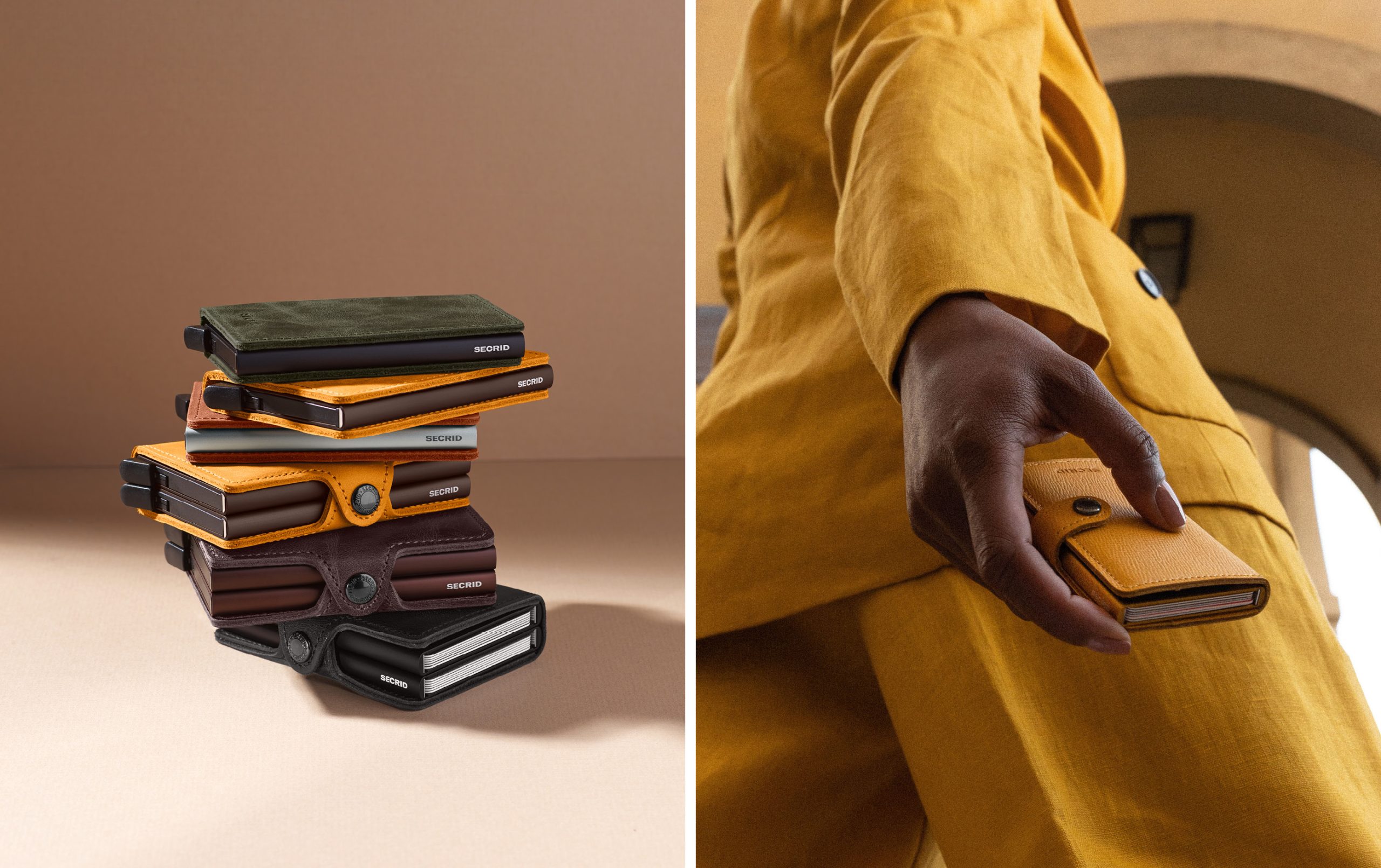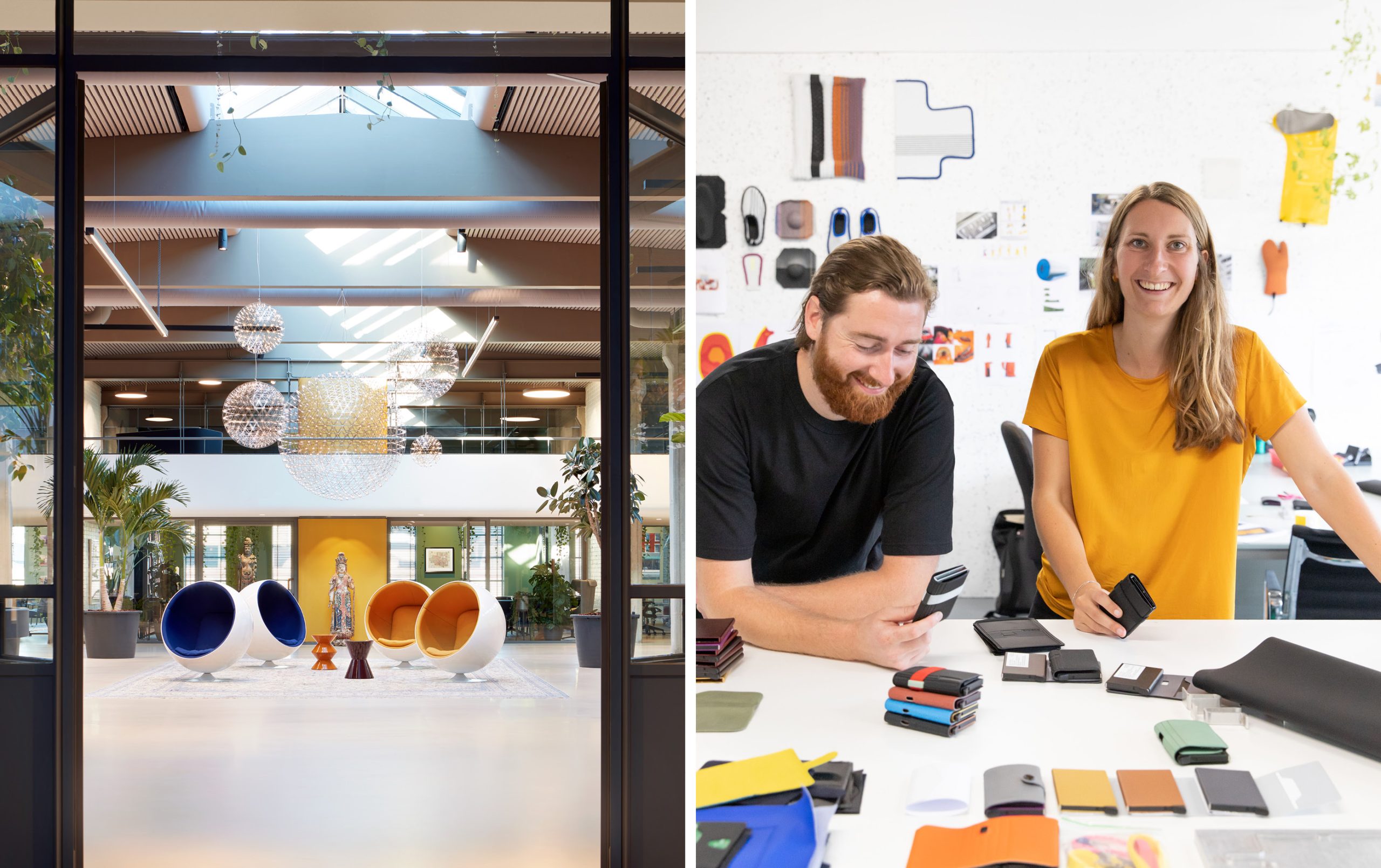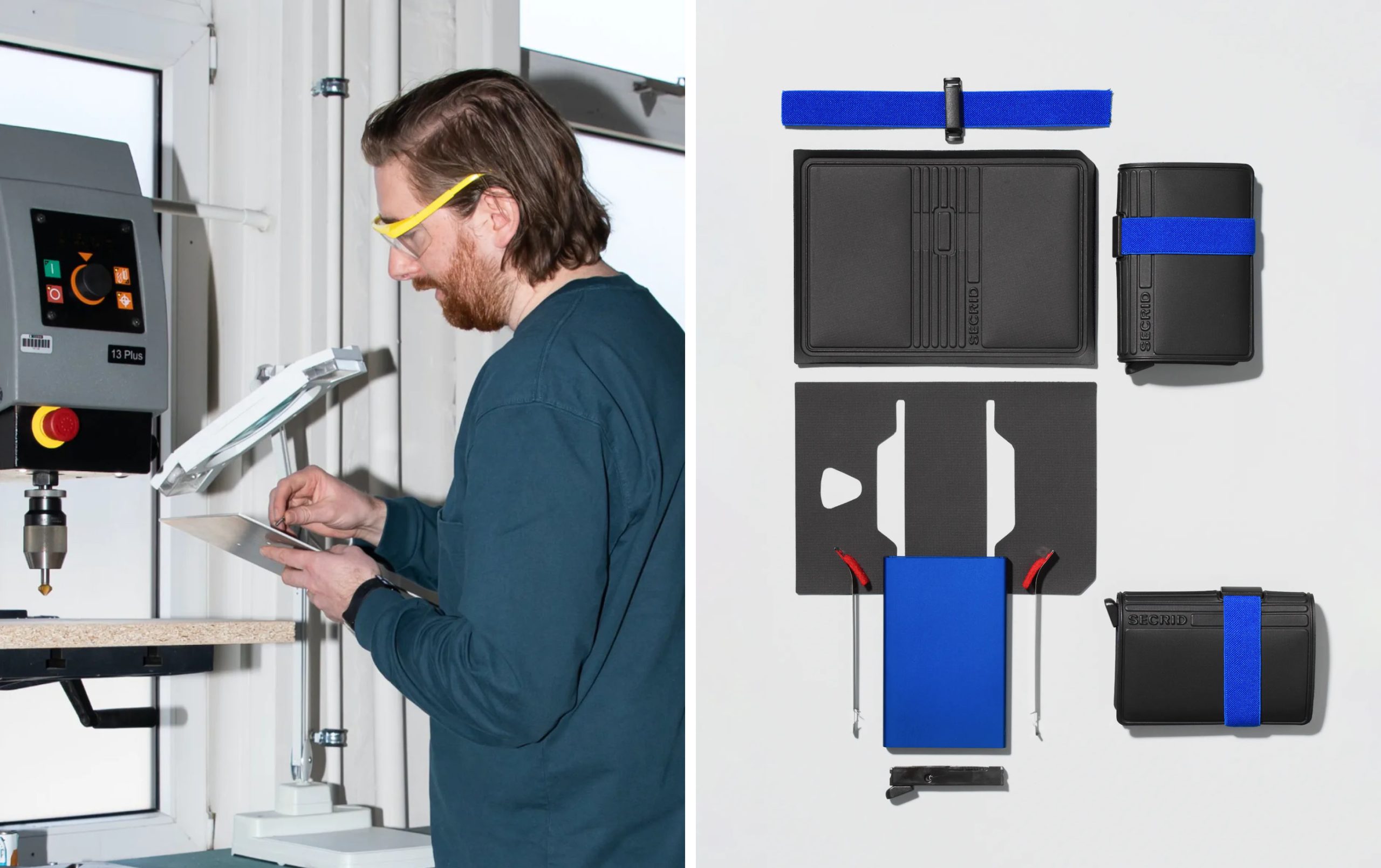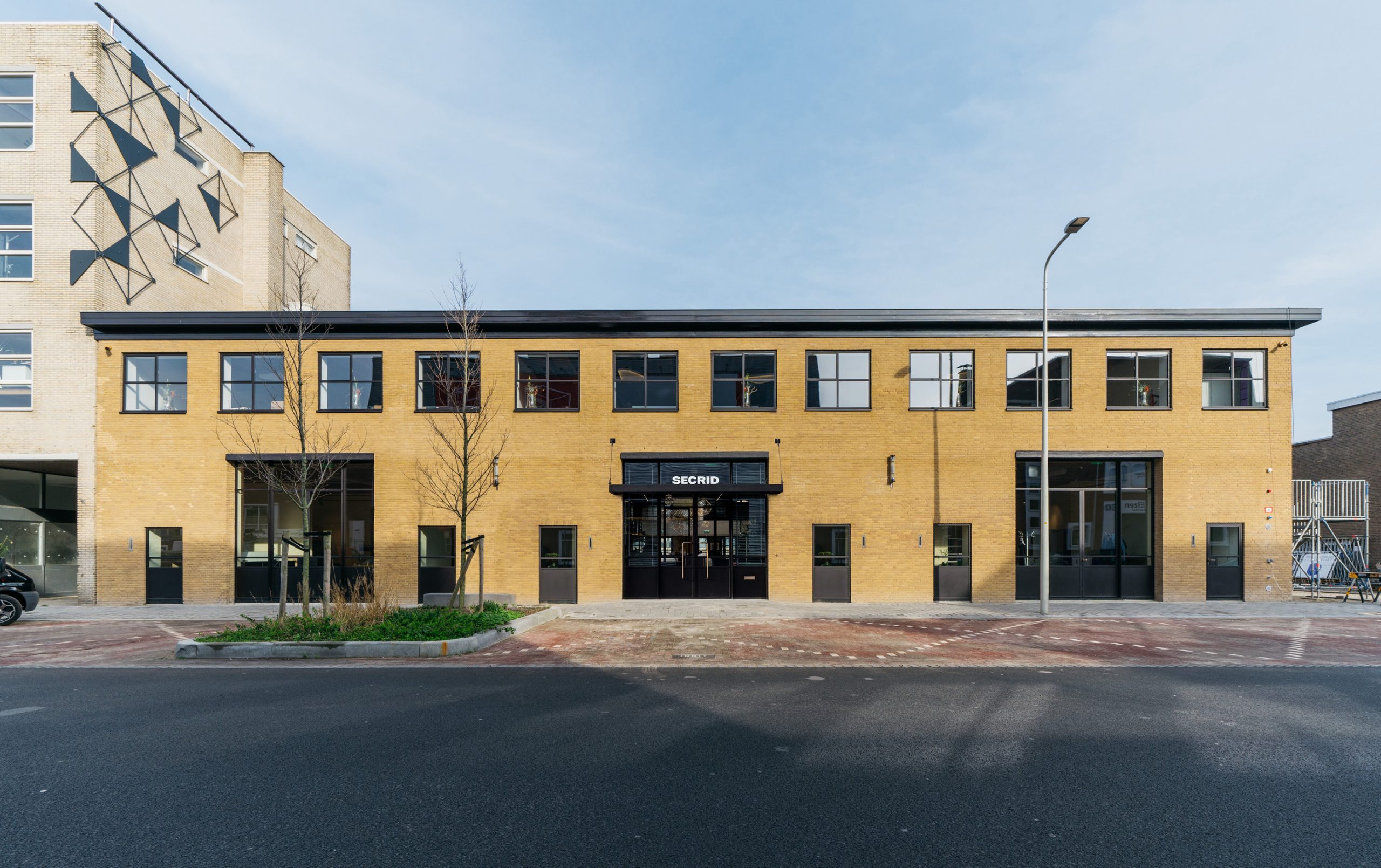Designer René van Geer believes that big changes often happen in small steps. This combination of vision and patience is what led René and his partner Marianne to establish Secrid, one of the most innovative and successful pocketwear brands in the Netherlands. Since launching their very first cardholder 27 years ago, Secrid has also become known for being a disruptive force in an industry that is notoriously tough to crack.
At the heart of everything they do is a design philosophy that places quality, people and planet before more typical goalposts like speed or profit. For example: instead of ‘cheaper and worse’, Secrid is only makes new products if they are intrinsically ‘better, more sustainable and more valuable’ than those that came before. This means developing materials and designs that are long-lasting, repairable and that can be produced as locally as possible.
It also means supporting the next generation of designers and makers through their new Secrid Impact Fund. What Design Can Do is thrilled to be working together with Secrid on this effort, through a collaboration which includes initiatives like the Secrid Talent Podium, together with the Dutch Design Foundation. We’re also excited to announce that René will be joining the international jury of the Make it Circular Challenge. As a designer with a wealth of knowledge in sustainable entrepreneurship, René will be helping us select the 13 winners of this year’s competition, to be announced in May. The most promising projects will receive a prize fund of €10.000 each, as well as access to a development programme designed to bring their start-ups to the next level.
Last week, we caught up with René to learn more about his approach to making consumer goods, the importance of circular design, and what he’ll be looking for in an outstanding idea. Read our full conversation below.

Secrid products: Made in Holland, and designed to last.
We’d love to know more about how you started Secrid. Can you tell us the story?
Well, we started as a design studio in 1989, making products for all kinds of clients. We worked in many markets and that’s what shaped my experience as a designer. We worked on everything from interior products to telecom and medical equipment, toys, even carseats.
Things started to change in the mid 90s. Chip cards were being introduced in the Netherlands by the banks, and we started to get a lot of projects based on them. That’s when we realised that actually, the wallet of the future is a cardholder. So we started designing our first cardholder as a side project. This was 1995 — a long time ago — and I think the market wasn’t ready for it. But we learned a lot and it was fun to do something different next to our usual design jobs.
And then in 2008, the financial crisis hit us hard. And as a design studio, we lost almost all of our clients. We were going to go bankrupt. We had plenty of hours, but no money. So what can you do as an experienced designer? Well, you could make a new product and try to sell it yourself. So that’s what we did. Thirteen years after making our first cardholder, we thought: let’s make a better one. The year before that the iPhone was introduced, and that was a game-changer for what people could have in their pockets. So based on that change in the world, we designed a new cardholder which was very high-end. From that moment on, Secrid started growing.
“We realised that the wallet of the future is a cardholder.”
Secrid is known for making beautiful products, but also for its clear vision and mission. How did this come about?
That’s something that happened in parallel with the whole design studio. When I graduated in 1986, sustainability wasn’t a big issue yet. It wasn’t something we learned about at university or read about in magazines. So it was not top-of-mind for most designers, and it wasn’t for me either.
But then we started working for a lot of companies who had their factories in places like China, Taiwan, Turkey, the Philippines and so on. So we travelled a lot. And we saw that in many of these factories, there was a lot of pollution, a lot of garbage, and they didn’t always take good care of their people. We started to realise, this is actually not something we want to be a part of — this is something that needs to be changed. And this was a growing feeling. It wasn’t a switch from one day to another. We got more and more critical as the years went by.
Then, in the beginning of 2000, we started saying ‘no’ to clients, telling them that we don’t want to do their projects because we don’t agree with the kinds of things they asked of us. Making products cheaper, not taking care of its quality, not taking care of its lifetime, not taking care of repairability — this kind of thing. So with our growing awareness we said ‘no’ to more and more clients, which is a financially difficult step for a design studio.
So when we had the crisis in 2008, we saw an opportunity to make our own brand. It was clear that we had to do it in a way that integrated everything we learned into our company. This was also the main reason that we didn’t want any external investors in our company. Because they’re usually the ones who hold you back, saying ‘no’ to things like extra cost for higher quality, or to develop a better design that actually serves people and planet. So it was also a principal decision for us to stay independent.

Left: One of Secrid’s classic Cardprotectors. Right: René and Marianne at work.
HOW DO YOU APPROACH CIRCULARITY AT SECRID?
The most important thing to us is our product’s lifetime. At Secrid we aim for a lifetime of at least ten years. That’s why we also offer a repair service — we have 500 repair points worldwide. They’re not very busy because our product is designed to be long-lasting, but if something does happen to your cardholder, we can repair it, and we do it for free. Meanwhile, we see a lot of copycats that make cardholders with a lifetime of less than one year, sometimes even less than one month. This is extremely short and it makes a big impact.
Another main issue for us is quality. During the past 30 years, we’ve spent a lot of time and effort in improving the quality of our products. We also made sure all their different parts can be easily separated so that they can be recycled. But I also have to be honest and say that we don’t do returns — the product is too small to send back to us because of all the shipping costs and emissions. If somebody in Japan ships their tiny cardholder back to Holland just to recycle it, it’s not the wise thing to do. So we try to look at these things holistically.
“By keeping our entire production process as local as possible, travelling times, shipping costs and CO2 emissions are limited.”
That’s also why almost everything we make is locally produced. When we first started in 2009, the leather industry had practically abandoned the Netherlands in favour of low-income countries. Secrid brought this industry back to our home country. By keeping our entire production process as local as possible, travelling times, shipping costs and CO2 emissions are limited. It also means you have a good view of how the working conditions are in the tannery and on the factory floor. It’s difficult to keep an eye on these things when it’s far away.
So when it comes to circularity, we see it as part of an evolutionary process. Every time, it’s about improving, improving, improving the product. And ours looks very simple, but over the years we have made a lot of progress on a lot of tiny details.


Product engineers and designers at Secrid’s main office, also called their ‘Heartquarters.’
What is something that excites you about the next generation of product designers?
I’ve been in the business for so many years already, so I’ve seen a lot of change. So much has shifted in the last thirty years, from making nice shapes to making great concepts based on things like sustainability, new materials, or how to use waste. And so the whole thinking behind design is shifting from styling to sustainability, and this is major. At Secrid we’ve actually started to consider style as a part of sustainability — because if you love something, we think you’re more likely to use it for longer and share it with others.
At the same time, we see that being really sustainable demands a lot of practical experience and holistic vision. And this is something that is difficult for young designers when you haven’t done many projects in the real world. Making something better, more sustainable, is not a linear road from A to B. Design is about making choices. And usually, if one thing becomes a little bit better, then another thing becomes a little less good. So design is also about solving dilemmas — and choosing what to improve and what to accept as a negative effect. It’s hardly ever a pure win-win. We’re already happy when we win-a-lot-and-lose-a-bit. And so the question is: how do you solve these dilemmas? How do you make the right choices? For this you need experience, and this is something which we can offer as a company. We like to talk with young designers and help them to see where the pitfalls are.
What made you decide to get involved with the Make it Circular Challenge?
Last year we launched the Secrid Impact Fund, which allows us to channel 1% of our yearly revenue to support projects that are driving change in our industries. We contacted What Design Can Do because we have a shared vision on the power of design, and because this is something that we see as important in our future: to support the next generation of designers and to help them to think holistically. And circularity is part of this vision.
“Commerce is often a dirty word in design, but it’s an important part of what makes a sustainable idea successful.”
That’s why we wanted to be part of this team and to see how we can use our expertise to improve the businesses of these designers. This is what the world is waiting for, what the world is needing. And for us it’s always interesting to see the questions that they have — which ranges from finance to how to find the right retailers, how to arrange the logistics of your manufacturing, your supply chain.
Another thing we look at is the commercial side of things. If you make something which is a beautiful miracle in design but nobody understands it, nobody sees it, nobody can sell it — it won’t have the effect on the world that it should have. Commerce is often a dirty word in design, but it’s an important part of what makes a sustainable idea successful. And this is something that we see as part of our mission at Secrid: to show other companies that you can do things as sustainably as possible and still be competitive and profitable.


Secrid’s Heartquarters also features a workshop where specialists can test materials and craft prototypes.
Besides the official criteria, what are some things you will be looking out for in a winning idea?
For me, it starts with the question: What’s the personal story behind it? How did you get to this idea? What is the reason why you started focusing on or solving this problem? That already tells me a lot about the idea and how to read it. I also think that very often certain problems are more visible in certain localities, and that’s important to be aware of. For example, as someone who lives in the Netherlands, there are a lot of problems in the world that we don’t see, but which are all caused by the consumption we have here in our country. That’s why it’s so interesting to have this international competition and to see how creatives around the world are responding to what’s happening in their societies. I’m also curious to see how designers are envisioning the future, and how they’re preparing for the issues that need to be solved in the coming decades.
“For me, a winning idea starts with the personal story behind it. How did you get to this idea? What is the reason why you started focusing on this problem?”
What is the best advice you could give to creative entrepreneurs that could help them succeed beyond this challenge?
Design is a very complex profession. To learn how to look at things holistically is an important part of making good design. But to look at things holistically is also time-consuming. So one of the major pieces of advice I often give is to be patient. When things are not successful the first time or the second time — or the third time or the fourth time — keep going. If you believe in something, you need to keep digging deeper to find the resources you need.
A nice example of this is our own Bodycard, which is the first cardholder we made in 1995. It was okay, but it was not a big success. The first reason: the design wasn’t special enough. Second reason: we were more than ten years too early on the market. We relaunched the product in 2009, integrating everything we learned into a new design. That was the moment it became successful. So fourteen years later, the timing was right. And once it became successful, people said to us, oh, why didn’t you start with this earlier? Actually we did start earlier, but it was not successful. We had to be patient and to keep improving and improving and improving. When you do that, things can suddenly take off.
This interview has been edited for length and clarity.
